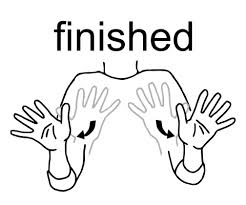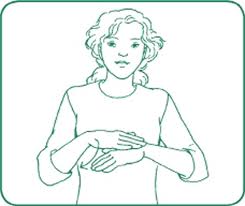Communicating with Infants Using Simple Signs
A long, long time ago I wrote about the concept of “more” as an early and important concept for infants and using the sign for “more” to communicate that concept with them. Today, I want to explore a few more signs that support early math learning with preverbal infants and that you can easily incorporate into your regular practice.
The most obvious place to use sign language with infants and older babies is at feeding time. Even the breastfed baby can begin to learn signs that indicate “more,” “all done,” and “hungry.”
When an infant begins to look or act like she is ready for a feeding, you can ask her if she is “hungry.” You do this by cupping one hand so it forms a “C” shape and then moving that shape from the bottom of your neck down toward your chest.
 When she shows signs that she is finished eating, you can ask her if she is “all done?”
When she shows signs that she is finished eating, you can ask her if she is “all done?”
 “All done” and “finished” are the same sign and mean the same thing. However, “all gone” is different and has a different meaning. For the child, “all done” is that way she feels – she doesn’t want anymore. But “all gone” means the food is finished even though she might not be “all done.”
“All done” and “finished” are the same sign and mean the same thing. However, “all gone” is different and has a different meaning. For the child, “all done” is that way she feels – she doesn’t want anymore. But “all gone” means the food is finished even though she might not be “all done.”
 How are these simple ideas mathematical? For our purposes, we can think about hunger as “emptiness” just as full (or all done) as “fullness.” These are simple notions of quantity as is “more.” Because the hunger signal is so strong and a means of self-preservation for the child, we can capitalize on it and use it as a springboard for other signs. Signing is a way to give language to children so they can express themselves before they speak. It eases frustration both on the part of the child as well as on the part of the caregiver.
How are these simple ideas mathematical? For our purposes, we can think about hunger as “emptiness” just as full (or all done) as “fullness.” These are simple notions of quantity as is “more.” Because the hunger signal is so strong and a means of self-preservation for the child, we can capitalize on it and use it as a springboard for other signs. Signing is a way to give language to children so they can express themselves before they speak. It eases frustration both on the part of the child as well as on the part of the caregiver.